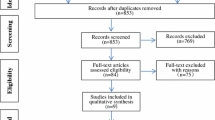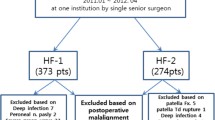Abstract
It is debatable whether high-flexion (HF) total knee arthroplasty (TKA) designs will improve postoperative flexion and function or will diminish the need for manipulation under anaesthesia (MUA). We retrospectively analysed range of motion (ROM), flexion, Knee Society Score (KSS), and rate of MUA in a consecutive group of patients who underwent TKA with a conventional posterior stabilised (PS) insert or an HF insert using identical surgical technique, implant design, and postoperative care. Fifty TKAs with a standard PS insert were matched for patient’s age, gender, preoperative ROM, and KSS with 50 TKA performed with an HF insert. The patient’s ROM and KSS were evaluated at six weeks, four months, and one year postoperatively. The outcome variables (flexion, ROM, KSS, and manipulation rate) in both groups were compared using the generalised estimating equations method. A second analysis of patients with preoperative flexion ≥120° was performed. The ROM, flexion, and patient-reported KSS was similar in both groups at each time period. The rate of MUA was also similar. Patients with a preoperative ROM of at least 120° showed similar results. Our study found that one year after surgery, patients who underwent TKA with a PS or an HF insert achieved similar flexion, ROM, and function.

Similar content being viewed by others
References
Bin SI, Nam TS (2007) Early results of high-flex total knee arthroplasty: comparison study at 1 year after surgery. Knee Surg Sports Traumatol Arthrosc 15:350–355
Coughlin KM, Incavo SJ, Doohen RR, Gamada K, Banks S, Beynnon BD (2007) Kneeling kinematics after total knee arthroplasty: anterior-posterior contact position of a standard and a high-flex tibial insert design. J Arthroplasty 22:160–165
D’Agostino R (1998) Tutorial in biostatistics propensity score methods for bias reduction in the comparison of a treatment to a non-randomized control group. Stat Med 17:2265–2281
Ewald FC (1989) The Knee Society total knee arthroplasty roentgenographic evaluation and scoring system. Clin Orthop Relat Res 248:9–12
Gandhi R, de Beer J, Leone J, Petruccelli D, Winemaker M, Adili A (2006) Predictive risk factors for stiff knees in total knee arthroplasty. J Arthroplasty 21:46–52
Gandhi R, Tso P, Davey JR, Mahomed NN (2009) High-flexion implants in primary total knee arthroplasty: a meta-analysis. Knee 16:14–17
Gonzalez Della Valle A, Leali A, Haas S (2007) Etiology and surgical interventions for stiff total knee replacements. HSS J 3:182–189
Gupta SK, Ranawat AS, Shah V, Zikria BA, Zikria JF, Ranawat CS (2006) The P.F.C. sigma RP-F TKA designed for improved performance: a matched-pair study. Orthopedics 29:S49–52
Han HS, Kang SB, Yoon KS (2007) High incidence of loosening of the femoral component in legacy posterior stabilized-flex total knee replacement. J Bone Joint Surg Br 89:1457–1461
Huang HT, Su JY, Wang GJ (2005) The early results of high-flex total knee arthroplasty: a minimum of 2 years of follow-up. J Arthroplasty 20:674–679
Insall JN, Dorr LD, Scott RD, Scott WN (1989) Rationale of the Knee Society clinical rating system. Clin Orthop Relat Res 248:13–14
Keating EM, Ritter MA, Harty LD, Haas G, Meding JB, Faris PM, Berend ME (2007) Manipulation after total knee arthroplasty. J Bone Joint Surg Am 89:282–286
Kim YH, Choi Y, Kwon OR, Kim JS (2009) Functional outcome and range of motion of high-flexion posterior cruciate-retaining and high-flexion posterior cruciate-substituting total knee prostheses. A prospective, randomized study. J Bone Joint Surg Am 91:753–760
Kim YH, Sohn KS, Kim JS (2005) Range of motion of standard and high-flexion posterior stabilized total knee prostheses. A prospective, randomized study. J Bone Joint Surg Am 87:1470–1475
Klein GR, Parvizi J, Rapuri VR, Austin MS, Hozack WJ (2004) The effect of tibial polyethylene insert design on range of motion: evaluation of in vivo knee kinematics by a computerized navigation system during total knee arthroplasty. J Arthroplasty 19:986–991
Kucera T, Urban K, Karpas K, Sponer P (2007) Restricted motion after total knee arthroplasty. Acta Chir Orthop Traumatol Cech 74:326–331
Laskin RS (2007) The effect of a high-flex implant on postoperative flexion after primary total knee arthroplasty. Orthopedics 30:86–88
MacDonald SJ (2009) Factors the affect patient outcome - the influence of a high flexion design. In Proceedings of The Knee Society Meeting, Las Vegas, NV
Maloney WJ (2002) The stiff total knee arthroplasty: evaluation and management. J Arthroplasty 17:71–73
McCalden RW, MacDonald SJ, Bourne RB, Marr JT (2009) A randomized controlled trial comparing hi-flex versus standard posterior cruciate substituting polyethylene tibial inserts in total knee replacement. In Proceedings of The 18th Annual Meeting of AAHKS. Dallas, TX
Meneghini RM, Pierson JL, Bagsby D, Ziemba-Davis M, Berend ME, Ritter MA (2007) Is there a functional benefit to obtaining high flexion after total knee arthroplasty? J Arthroplasty 22:43–46
Minoda Y, Aihara M, Sakawa A, Fukuoka S, Hayakawa K, Ohzono K (2009) Range of motion of standard and high-flexion cruciate retaining total knee prostheses. J Arthroplasty 24:674–680
Moynihan AL, Varadarajan KL, Hanson GR, Park SE, Nha KW, Suggs JF, Johnson T, Li G (2009) In vivo knee kinematics during high flexion after a posterior-substituting total knee arthroplasty. Int Orthop E-pub ahead of print. DOI: 10.1007/s00264-009-0777-2
Murphy M, Journeaux S, Russell T (2009) High-flexion total knee arthroplasty: a systematic review. Int Orthop 33:887–893
Nagura T, Dyrby CO, Alexander EJ, Andriacchi TP (2002) Mechanical loads at the knee joint during deep flexion. J Orthop Res 20:881–886
Nagura T, Otani T, Suda Y, Matsumoto H, Toyama Y (2005) Is high flexion following total knee arthroplasty safe?: evaluation of knee joint loads in the patients during maximal flexion. J Arthroplasty 20:647–651
Ng FY, Wong HL, Yau WP, Chiu KY, Tang WM (2008) Comparison of range of motion after standard and high-flexion posterior stabilized total knee replacement. Int Orthop 32:795–798
Noble PC, Gordon MJ, Weiss JM, Reddix RN, Conditt MA, Mathis KB (2005) Does total knee replacement restore normal knee function? Clin Orthop Relat Res 431:157–165
Nutton RW, van der Linden ML, Rowe PJ, Gaston P, Wade FA (2008) A prospective randomized double-blind study of functional outcome and range of flexion following total knee replacement with the NexGen standard and high flexion components. J Bone Joint Surg Br 90:37–42
Pariente GM, Lombardi AV Jr, Berend KR, Mallory TH, Adams JB (2006) Manipulation with prolonged epidural analgesia for treatment of TKA complicated by arthrofibrosis. Surg Technol Int 15:221–224
Park KK, Chang CB, Kang YG, Seong SC, Kim TK (2007) Correlation of maximum flexion with clinical outcome after total knee replacement in Asian patients. J Bone Joint Surg Br 89:604–608
Ranawat CS (2003) Design may be counterproductive for optimizing flexion after TKR. Clin Orthop Relat Res 416:174–176
Ritter MA (2006) High-flexion knee designs: more hype than hope? In the affirmative. J Arthroplasty 21:40–41
Seon JK, Song EK, Lee JY (2005) Comparison of range of motion of high-flexion prosthesis and mobile-bearing prosthesis in total knee arthroplasty. Orthopedics 28:s1247–1250
Sultan PG, Most E, Schule S, Li G, Rubash HE (2003) Optimizing flexion after total knee arthroplasty: advances in prosthetic design. Clin Orthop Relat Res 416:167–173
Walton NP, Jahromi I, Dobson PJ, Angel KR, Lewis PL, Campbell DG (2005) Arthrofibrosis following total knee replacement. Does therapeutic warfarin make a difference? Knee 12:103–106
Weeden SH, Schmidt R (2007) A randomized, prospective study of primary total knee components designed for increased flexion. J Arthroplasty 22:349–352
Weiss JM, Noble PC, Conditt MA, Kohl HW, Roberts S, Cook KF, Gordon MJ, Mathis KB (2002) What functional activities are important to patients with knee replacements? Clin Orthop Relat Res 404:172–188
Whiteside LA (2002) Soft tissue balancing: the knee. J Arthroplasty 17:23–27
Yercan HS, Sugun TS, Bussiere C, Ait Si Selmi T, Davies A, Neyret P (2006) Stiffness after total knee arthroplasty: prevalence, management and outcomes. Knee 13:111–117
Acknowledgements
We are grateful to Mrs. Victoria Bidwell, Mr. Richard Sorgini, the Eleanor Jennings Myatt Memorial Fund, Dr. Eduardo Salvati and Dr. Thomas Sculco who provided funding for this study. We are grateful to Dr. Stephen Haas for his collaboration in the description of the high-flexion implant design used in our study.
Conflict of interest
None.
Author information
Authors and Affiliations
Corresponding author
Rights and permissions
About this article
Cite this article
Malik, A., Salas, A., Ben Ari, J. et al. Range of motion and function are similar in patients undergoing TKA with posterior stabilised and high-flexion inserts. International Orthopaedics (SICOT) 34, 965–972 (2010). https://doi.org/10.1007/s00264-009-0865-3
Received:
Revised:
Accepted:
Published:
Issue Date:
DOI: https://doi.org/10.1007/s00264-009-0865-3




